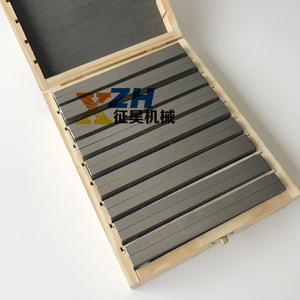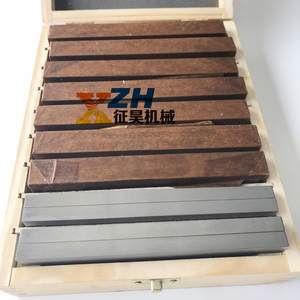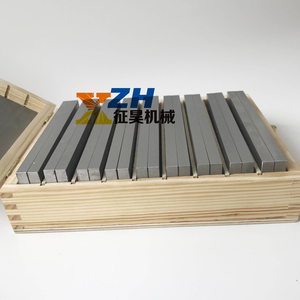
All categories
Featured selections
Trade Assurance
Buyer Central
Help Center
Get the app
Become a supplier

(969 products available)



























Industrial machinists use precision parallel sets to support and accurately adjust the workpiece in the vise, lathe, or other machinery. These parallel sets have different types, including the following:
They are the most common type of parallel set. The rectangular parallel set is made of steel or alloy. Their thickness is the same, while the width and length are different. The set usually contains several pairs of parallels of different lengths, thus allowing for versatility in various machining tasks.
Similar to the rectangular parallel sets, square parallel sets have the same thickness and width but different lengths. Square parallel sets can be used for a variety of tasks, such as setting the workpiece at the same height or providing the necessary support for the workpiece. They provide a square contact surface for the workpiece. Square parallel sets are suitable for situations that require a larger support area.
Thin parallel sets are thinner than regular parallel sets. They are suitable for occasions that need to clamp narrow workpieces or work in confined spaces. Thin parallel sets are also suitable for fine machining tasks where heavy-duty precision parallels are not needed.
Adjustable parallel sets are equipped with an adjustable screw or locking mechanism. The mechanism allows the height of the parallel to be easily adjusted and fixed to adapt to different workpiece thicknesses. Adjustable parallel sets are easy to use and convenient for quick setup and adjustment.
V-block parallel sets are designed to hold round or cylindrical workpieces. They have a V-shaped groove that provides a stable and secure grip. V-block parallel sets are often used in centering, drilling, and other machining operations. The clamp set is equipped with a clamp that can be used to quickly and securely fix the workpiece in place.
Material: The mhc precision parallel set is typically made of steel, stainless steel, or other materials with high hardness and wear resistance to ensure durability.
Dimensions: The length, width, and height of the parallel set are usually specified to meet different precision machining requirements. They may range from a few inches to more than ten inches.
Parallelism Accuracy: The precision of the parallelism refers to how precisely the two faces of the parallel set are parallel to each other. It is usually expressed in units of length, such as micrometers or millionths of an inch. The parallelism accuracy of the parallel set can be as high as a few micrometers or even less.
Surface Finish: The surface finish of the precision ground parallels set is usually ground or honed to achieve a smooth and flat surface. This makes the parallel set easier to slide in and out of position under the workpiece.
Set Size: The number of pieces in a precision parallel set is typically four, six, ten, or more. A set with more pieces can provide finer height adjustment and more versatile use.
Clean: After use, clean the precision parallel set with a clean, dry cloth to remove any dirt, debris, or coolant. Ensure the parallel set is thoroughly cleaned to prevent any contamination to the workpiece during the next use.
Use rust prevention: Apply a thin layer of rust inhibitor to the parallel set's surface to protect against rust and corrosion. Store the parallel set in a dry, humidity-controlled environment to avoid dampness and prevent rusting.
Do not overload: When using the precision parallel set, avoid overloading the workpiece. This can prevent deformation or damage to the parallel set, ensuring its accuracy and stability.
Avoid impact: The parallel set should avoid strong impacts during use or storage to prevent damage to the parallelism and surface finish.
Regular inspection: Periodically inspect the parallel set for any signs of damage, wear, or deformation. If any issues are found, they should be repaired or replaced promptly to maintain the parallel set's precision and performance.
As mentioned earlier, parallel sets are used in a variety of industries to set up machinery and equipment with high precision.
Parallel sets are used to set up fixtures and jigs with the required precision in the manufacturing and assembly of automotive components. Automotive parallel sets are also used for the accurate alignment and positioning of engine parts, chassis, body panels, and other components.
In woodworking, parallel sets are mainly used for setting up woodworking machines, such as table saws, planers, and jointers, to ensure the parallel alignment of cutting blades and work surfaces. Parallel sets are also used in the assembly and clamping of wooden components to achieve precise parallelism and uniformity.
For machinists who require precise parallelism, parallel sets are used to set up milling machines, lathes, and other metalworking equipment to achieve accurate machining operations. Metalworking parallel sets are also used in the assembly of metal components, such as shafts, gears, and bearings, to ensure proper alignment and parallelism.
In the machine tool and fixture manufacturing industry, parallel sets are used to make machine tool components, such as vise jaws, fixture plates, and tool holders. Parallel sets ensure that the workpiece is securely held and positioned with accuracy. Parallel sets are also used to set up and align fixtures for machining operations, such as drilling, milling, and grinding, to ensure the proper orientation of the workpiece.
Parallel sets are also used in quality control and precision inspection applications to verify the parallelism of machined surfaces or components. Precision parallel sets are frequently used in calibration laboratories and metrology to calibrate and verify the accuracy of measuring instruments.
Parallel sets are essential tools in various industries to achieve precise parallel alignment and positioning in the setup of machinery, assembly of components, and quality control processes.
Choosing the right precision parallel set for one's work depends on several factors, including the intended application, materials, quality requirements, and specifications.
Consider the specific requirements of the project. What is the purpose of using a parallel set? Determine whether the project requires precise alignment, spacing, or support, and choose the appropriate parallel set based on these needs.
Select parallel sets that match the project's workpiece and environmental conditions. Common parallel set materials include stainless steel, carbon steel, and brass. If the set requires non-magnetic or non-conductive properties, other materials, such as plastic or ceramic, may be considered.
For projects that require very high precision, parallel sets with tight tolerances and excellent surface quality should be considered. Choose parallel sets with precise flatness and parallelism to ensure accurate and consistent results.
Select the parallel set that matches the project's size and specifications. Consider factors such as length, width, height, and incremental size options. Ensure that the chosen parallel set can meet the project's specific requirements.
For some long-term projects, parallel sets that are easy to maintain and clean should be chosen. Choose parallel sets with surface treatments that are resistant to rust and corrosion. This can help prolong the parallel set's service life and reduce the need for frequent replacement.
Q1 What is a precision parallel set used for?
A1 A precision parallel set is used to support irregular or delicate workpieces and to provide stability and accuracy during machining, assembly, or inspection processes.
Q2 What is the difference between a precision parallel set and a common parallel set?
A2 The precision parallel set is made of high-quality steel and has higher manufacturing tolerances than the common parallel set, allowing it to achieve more precise adjustments and maintain parallelism within very tight limits.
Q3 Can the parallel set be used without a parallel clamp?
A3 Yes, in many cases, parallel sets can be used without parallel clamps. They can be placed directly on the workbench or machine to support the workpiece.